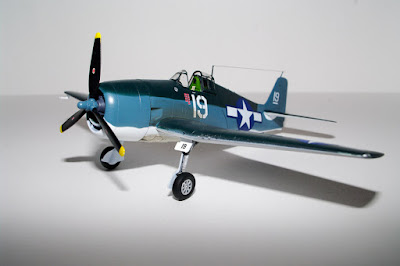Grumman F6F-3 Hellcat
Eduard ProfiPACK, 1/72 scale
VF-6, USS Intrepid
Lt. Alexander Vraciu
February 1944
This model was painted with Tamiya paints topped off with some coats of Micro Satin before and after decals were applied. Some light weathering was used. I am not a great fan of extensive weathering. I know warbirds looked pretty grungy much of the the time (if they lasted long enough), but I simply prefer the “fresher” type finish.
I really like ProfiPACK kits, as they are so complete, give you a choice of many markings, and the decals are first-rate. In today’s market with today’s prices, I think they represent a good value.
Chance Vought F4U-1 Corsair “Bird Cage”
Tamiya, 1/48/ scale
VMF-124
Guadalcanal, May 1943
Pilot: Lt. Ken Walsh (first one day ace)
I always liked the look of the “Birdcage”. This is a typical Tamiya kit - excellent fit and detailed parts. One of my interests is the Battle of Guadalcanal. The aircraft modeled here is a veteran of that campaign. Ken Walsh went on too fight in Korea and Vietnam, and he retired a full colonel.
The decals came from an old Aeromaster sheet (I guess they are all "old" now). I added some Eduard seat belts. Aside from that, this one is straight from the box. Paint is by Vallejo.
Jagdpanzer 38(t) Hetzer - Early Version
Academy 1/35 scale
1944-1945 - Unknown Wehrmacht Unit
The Hetzer (“hunter”) was a light anti-tank vehicle built on a Czechoslovakian chassis. The same basic chassis was put to use as an anti-tank gun and artillery piece. I believe it served on all fronts during the war and even served with the French Army after the war.
I wanted to build an Academy armor model, and I chose this one. I was pleased with the fit and the apparent accuracy. This was my first experience with link and length tracks, and I enjoyed it. Patience is required as you must let the glue set and dry before you move on or the tracks keep falling apart. I see that many new kits are including a jig that allows you to assemble you link and length tracks off the model. That is a real convenience. Hopefully we are at the end of vinyl track era.
Colors by Vallejo. Decals from a Tamiya kit. I applied them to dress it up a bit. The model was weathered with some Tamiya Panel Line Accent Colors (dark brown and black).
 |
| A Hetzer during the Warsaw Uprising |
 |
| Compared to a King Tiger |
Thank you for looking. Best Wishes for a Happy New Year!

















































